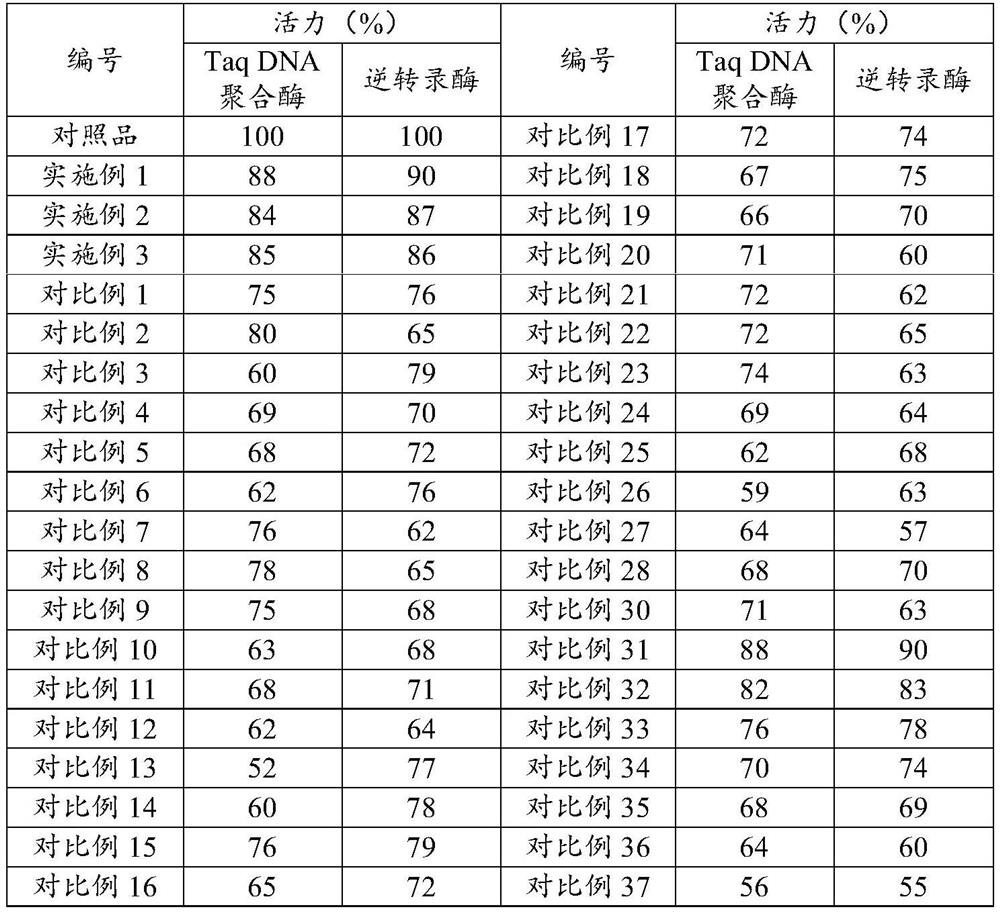A kind of co-immobilization method and application of dna polymerase and reverse transcriptase
A technology of reverse transcriptase and polymerase, which is applied in the field of enzyme engineering, can solve the problems of no co-immobilization method of DNA polymerase and reverse transcriptase, and achieve the effects of improving catalytic efficiency, stability and high enzyme activity
- Summary
- Abstract
- Description
- Claims
- Application Information
AI Technical Summary
Problems solved by technology
Method used
Image
Examples
Embodiment 1
[0050] The co-immobilization method of Taq DNA polymerase and MMLV reverse transcriptase in this embodiment comprises the following steps:
[0051] (1) Add 0.25g of sodium alginate to 5mL of phosphate buffer containing 0.2mol / L sodium chloride, the pH of the reaction is 6.5, then add 0.0020g of Taq DNA polymerase, mix and fix at 30°C for 2 hours , vacuum-dried to obtain immobilized Taq DNA polymerase;
[0052] (2) Add 5 mL of Tris-HCl buffer solution containing 0.2 mol / L sodium chloride to the immobilized Taq DNA polymerase, the pH value of the reaction is 9.0, then add 0.0030 g of reverse transcriptase, after mixing at 30 ° C Fix for 3 hours, vacuum-dry, and then wash with the Tris-HCl buffer solution containing 0.2mol / L sodium chloride, until no free DNA polymerase and reverse transcriptase are detected in the washing solution;
[0053] (3) Freeze-dry under the condition of temperature of -20°C and pressure of 40Pa to obtain co-immobilized Taq DNA polymerase and reverse tra...
Embodiment 2
[0055] The co-immobilization method of Taq DNA polymerase and MMLV reverse transcriptase in this embodiment comprises the following steps:
[0056] (1) Add 0.20g of sodium alginate to 6mL of phosphate buffer solution containing 0.1mol / L sodium chloride, the reaction temperature is , and the pH value of the reaction is 7.0, then add 0.0016g of Taq DNA polymerase, and mix at 33°C Post-fix for 1.5h, and vacuum-dry to obtain immobilized Taq DNA polymerase;
[0057] (2) Add 6 mL of Tris-HCl buffer containing 0.1 mol / L sodium chloride and 0.0036 g of reverse transcriptase to the immobilized Taq DNA polymerase, the pH of the reaction is 8.5, mix at 33°C and fix for 2.5 h , vacuum-dried, and then washed with a Tris-HCl buffer solution containing 0.3mol / L sodium chloride, until no free DNA polymerase and reverse transcriptase were detected in the washing solution;
[0058] (3) Freeze-dry under the condition of temperature of -15°C and pressure of 50Pa to obtain co-immobilized Taq DNA ...
Embodiment 3
[0060] The co-immobilization method of Taq DNA polymerase and MMLV reverse transcriptase in this embodiment comprises the following steps:
[0061] (1) Add 0.30g of sodium alginate to 4mL of phosphate buffer solution containing 0.3mol / L sodium chloride, the reaction temperature is , the reaction pH value is 6.0, then add 0.0024g of Taq DNA polymerase, mix at 27°C After fixing for 2.5 hours, vacuum-dry to obtain immobilized Taq DNA polymerase;
[0062] (2) Add 4 mL of Tris-HCl buffer containing 0.3 mol / L sodium chloride and 0.0024 g of reverse transcriptase to the immobilized Taq DNA polymerase, the pH of the reaction is 9.5, mix at 27°C and fix for 3.5 h , vacuum-dried, and then washed with a Tris-HCl buffer solution containing 0.1mol / L sodium chloride, until no free DNA polymerase and reverse transcriptase were detected in the washing solution;
[0063] (3) Freeze-dry under the condition of temperature of -25°C and pressure of 30Pa to obtain co-immobilized Taq DNA polymerase...
PUM
 Login to View More
Login to View More Abstract
Description
Claims
Application Information
 Login to View More
Login to View More - R&D
- Intellectual Property
- Life Sciences
- Materials
- Tech Scout
- Unparalleled Data Quality
- Higher Quality Content
- 60% Fewer Hallucinations
Browse by: Latest US Patents, China's latest patents, Technical Efficacy Thesaurus, Application Domain, Technology Topic, Popular Technical Reports.
© 2025 PatSnap. All rights reserved.Legal|Privacy policy|Modern Slavery Act Transparency Statement|Sitemap|About US| Contact US: help@patsnap.com



